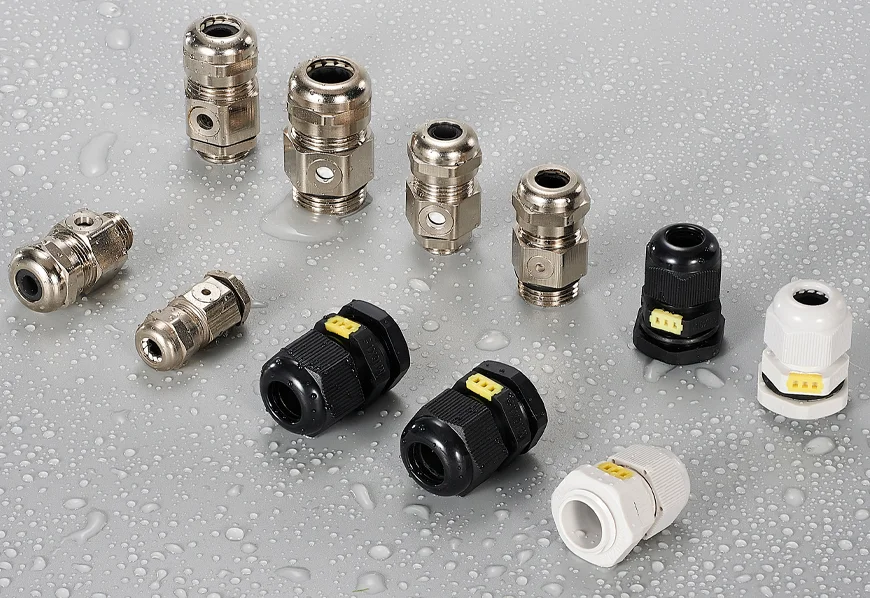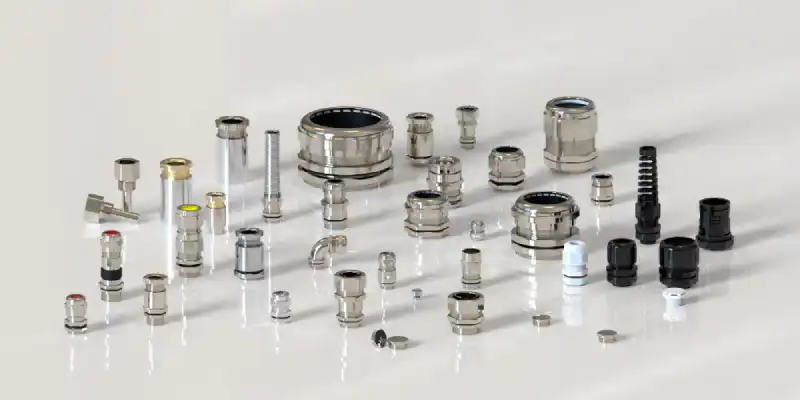통기성 케이블 글랜드와 표준 케이블 글랜드는 전기 시스템에서 케이블 관리를 위한 두 가지 솔루션으로, 각각 특정 환경 문제를 해결하도록 설계되었습니다. 둘 다 케이블을 고정하고 환경을 보호한다는 근본적인 목적은 같지만 설계 철학, 작동 메커니즘, 적용 상황은 크게 다릅니다. 이 보고서는 재료 과학, 기계 공학 원리 및 산업 응용 데이터를 바탕으로 종합적인 기술 비교를 제공하여 고유한 특성과 최적의 사용 사례를 설명합니다.
기본 설계 및 구축
통기성 케이블 글랜드
통기성 케이블 글랜드는 일반적으로 발포 폴리테트라플루오로에틸렌(ePTFE)으로 구성된 벤팅 멤브레인을 설계에 통합합니다. 이 미세 다공성 멤브레인은 액체, 먼지, 오염 물질은 차단하면서 공기와 증기 분자는 통과시켜 IP68 방수 등급을 달성합니다. 글 랜드의 구조는 다음과 같습니다:
- 본체와 너트: 내식성과 내구성을 위해 니켈 도금 황동 또는 나일론 PA66으로 제작되었습니다.
- 씰링 구성 요소: 폴리클로로프렌-니트릴 고무(CR/NBR) 씰과 폴리아미드 클램핑 인서트는 케이블 고정과 방수 밀봉을 보장합니다.
- 열 관리: ePTFE 멤브레인은 열 방출을 촉진하는 동시에 온도 변동으로 인한 내부 및 외부 압력 차이를 균등화합니다.

표준 케이블 글랜드
표준 케이블 글랜드는 기계적 고정과 기본적인 환경 밀봉을 우선시합니다. 대신 압력 균등화 기능이 부족합니다:
- 단일 또는 이중 압축 메커니즘: 케이블 외피와 절연을 보호합니다.
- 소재 다양성: 황동, 스테인리스 스틸 또는 나일론, 특수 장갑 또는 방폭형 글랜드 등 다양한 변형이 가능합니다.
- 간소화된 봉인: 능동적 환기 기능 없이 고무 개스킷 또는 O링에 의존하여 유입을 방지합니다.
주요 구조적 차이는 통기성 땀샘에는 공기 흐름을 위한 통기 막이 있는 반면, 일반 땀샘에는 통기 막이 없다는 점입니다.

기능적 성능
압력 균등화 및 응축 완화
통기성 케이블 글랜드는 응결이 발생하기 쉬운 환경에서 탁월한 성능을 발휘합니다. ePTFE 멤브레인은 압력 차이의 균형을 유지하여 습기 축적을 방지하여 부식이나 전기적 결함의 위험을 줄여줍니다. 예를 들어, 온도 변화에 노출되는 LED 조명에서 통기성 글랜드는 밀폐형 시스템에 비해 습도를 60~80%까지 줄여줍니다.
반면 표준 글랜드는 내부 습기를 가두는 정적 밀봉을 생성하므로 결로 현상이 발생하기 쉬운 환경에서는 건조제 패킷이나 드립홀과 같은 보조 솔루션이 필요합니다.
환경 보호 지표
- IP 등급: 두 글랜드 유형 모두 IP68 보호 등급을 획득했지만 통기성 글랜드는 공기 흐름을 허용하면서 이 등급을 유지합니다.
- 온도 복원력: 통기성 땀샘은 -40°C~120°C에서 작동하여 열 방출을 지원합니다. 표준 땀샘은 이 범위와 일치하지만 통합 열 조절 기능이 없습니다.
- 기계적 견고성: 이중 압축 표준 땀샘은 멤브레인 성능에 초점을 맞춘 통기성 모델에 비해 더 높은 축 방향 당김력을 견뎌냅니다.
애플리케이션 컨텍스트
통기성 케이블 글랜드
- LED 및 태양광 산업: 조명기구와 배선함의 김서림을 방지하세요.
- 실외 통신: 5G 인클로저의 습기 유입을 완화하는 동시에 열 조절의 균형을 맞출 수 있습니다.
- 해양 및 오프쇼어: 열악한 환경에서 내염수성 및 압력 균등화 기능을 제공합니다.
표준 케이블 글랜드
- 산업 자동화: 통제된 실내 환경에서 모터 연결을 보호하세요.
- 위험 지역: 방폭형은 석유화학 플랜트에서 가스 유입을 방지합니다.
- 데이터 센터: 장갑 글랜드는 케이블 트레이에서 광케이블을 보호합니다.
설치 및 유지 관리 고려 사항
통기성 땀샘
- 멤브레인 처리: ePTFE 멤브레인에 구멍을 뚫지 말고 부드러운 턱 도구를 사용하는 것이 좋습니다.
- 청소 프로토콜: 주기적인 점검을 통해 통기성을 보장하며, 청소에는 이소프로필 알코올을 사용합니다.
- 케이블 호환성: 골판지나 외장형보다는 매끄러운 피복 케이블에 가장 적합합니다.
표준 땀샘
- 압축 튜닝: 케이블 피복 손상을 방지하기 위해 정밀한 토크가 필요합니다.
- 환경 페어링: 화학 플랜트용 스테인리스 스틸과 같은 적절한 소재 선택은 매우 중요합니다.
경제성 및 운영상의 장단점
| 요인 | 통기성 땀샘 | 표준 땀샘 |
|---|---|---|
| 비용 | ePTFE 멤브레인으로 인해 30-50% 더 높음 | 초기 비용 절감 |
| 수명 | 10년 이상 멤브레인 무결성 유지 | 비부식성 환경에서 15년 이상 사용 가능 |
| 에너지 효율성 | 능동형 환기 시스템의 필요성 감소 | 보조 제습이 필요할 수 있습니다. |
| 개조 | 기존 인클로저와 호환 | 응결이 없는 애플리케이션에 한함 |
결론
통기성 케이블 글랜드는 기존 씰링 방법의 문제인 결로 및 압력 차이를 해결하는 케이블 관리의 특별한 진화를 나타냅니다. ePTFE 멤브레인 기술은 환경 보호와 수동적 기후 제어라는 두 가지 기능을 지원하므로 재생 에너지, 해양 및 통신 분야에서 필수 불가결한 제품입니다. 표준 글랜드는 견고한 기계적 유지력과 위험에 특화된 설계를 제공하는 일반 산업 애플리케이션의 주력 제품입니다.
이러한 시스템 간의 선택은 환경 역학에 따라 달라집니다. 열에 휘발성이 있고 습기에 민감한 환경에 적합한 통기성 글랜드와 정적이고 기계적으로 까다로운 설치에 적합한 표준 글랜드가 있습니다. 향후에는 실시간 멤브레인 상태 모니터링을 위해 스마트 센서를 통합한 하이브리드 설계가 등장하여 이 두 범주 사이의 경계가 더욱 모호해질 수 있습니다.


